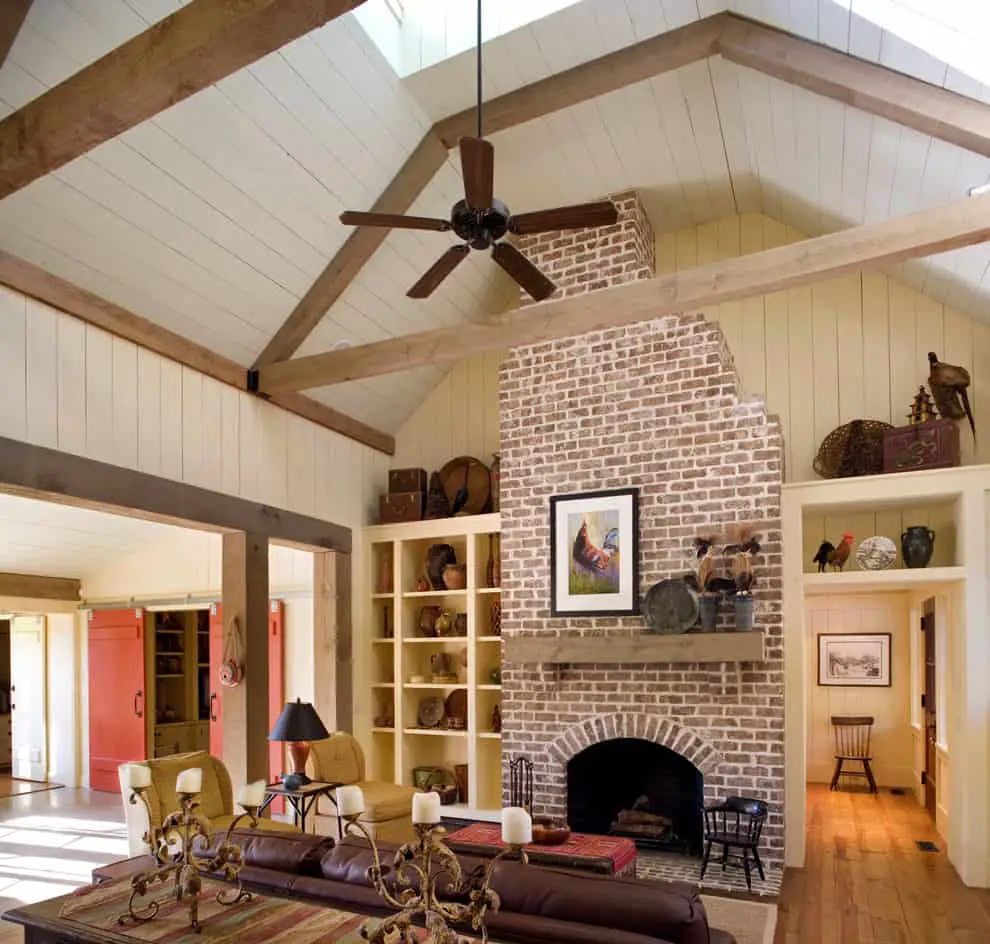Old houses hold a charm that is hard to deny. Perhaps it is because these homes are crammed with the stories of those that have gone before us. Many old houses are quaint and cosy, others have grander proportions. And these loftier homes have an allure and elegance all their own.
When visiting historic homes we often find ourselves marvelling at the lofty heights of the ceilings above. These soaring expanses, often adorned with intricate mouldings, grand chandeliers and gilded murals, weave together history, culture and design.
As such, these high ceilings in old houses stand as a testament to the craftsmanship and vision of generations past.
so why do old houses have high ceilings? It is because of the ‘grandiose’ ideas of the architects of the past that many old houses have high ceilings. But is that the only reason? Let’s discover the various reasons why some old homes have high ceilings.
Why Were Ceilings So High in Old Buildings?
Grand historic homes are not the only old houses that have high ceilings. Indeed, some houses with high ceilings are much smaller than the manor houses or estates we might visit to ‘ooh’ and ‘aah’ at.
It is likely, though, that many homes with high ceilings are going to be on the larger side. You won’t find high ceilings in cottages, for example.
And, the reason behind old buildings that do boast grandiose ceiling heights takes us on a journey through time, revealing a blend of practicality and aesthetics that shaped architectural choices.
The Higher the Ceiling, the Closer to God
Some of the highest buildings to be built first in the UK were our cathedrals. If you think of the cathedrals that began to be built almost a millennia ago, such as Wells or Winchester, you’ll find constructions that were both sophisticated and awe-inspiring.
They were being built to the glory of God but they had an eye on less godly considerations too.
Firstly, the bigger the cathedral, the more impressive it would be. The size and complexity of design would reflect positively on the people responsible for its construction both to God and to their fellow humans. The higher the ceilings, the better, if you want to impress your peers.
But the ceiling height would also be a boon to the acoustics of the structure which was essential when worship was largely sung.
It also meant that the walls and ceilings would have more scope for the frescoes and decorative aspects that would have been painted on the interiors. These painted interiors were largely destroyed or whitewashed during and after the Reformation.
But when they existed, they would have been a testament to the devotion of the Cathedral’s patron and act as a status symbol at the same time.

Castle Ceilings – The Height of Power
Like cathedrals, stone castles that were built from the turn of the last millennium onwards were constructed primarily as a symbol of power. One of the main ways that William the Conqueror declared his dominance over the English was to start the construction of these stone castles.
Many of these castles would have multiple chambers with high ceilings. The ceilings in these rooms were meant to instil awe to visitors. Especially as high ceilings in normal homes would have been very rare.
At a time when construction materials and techniques were far from advanced and most people lived in single-storey houses, castles required robust support systems to carry the weight of the structure. This often meant thicker walls and more substantial columns.
High ceilings emerged as a solution to accommodate these structural necessities while creating spacious interiors at the same time.
With higher ceilings, architects and builders could also incorporate larger windows, allowing more natural light to flood the rooms—a priceless asset in times before the advent of electric lighting.
Built To Impress
From the Middles Ages onwards, many grand homes incorporated high ceilings for the same reasons as castles and cathedrals – to impress.
Even when they were built from materials that were fashionable at the time of construction, such as red brick, local stone or imported marble, high ceilings can be found in homes where the owner had a certain status to uphold.
Think of the lofty ceilings in Restoration and Georgian homes. And in Victorian ones too, especially as a result of the rise of the nouveaux riches during the Industrial Revolution, who were desperate to build homes that created a ‘wow’ factor.
Even today, larger homes will often have lofty ceilings. It allows for a greater sense of space and freedom and there’s no doubt that large rooms and high ceilings still scream ‘money’ just as it always has.
What is the Purpose of High Ceilings?
There’s no one purpose behind high ceilings – they were designed for a number of reasons.
Cleaner Air
But there is some practical history behind high ceilings too. And that history guides us back to the fires that provided the main source of heat and hot water in larger historical homes.
Couple that with the lighting from candles and, later, oil lamps, and the fact that from the 1600s a large proportion of the adult population smoked tobacco, you get a smoky and a rather smelly room.
The higher ceiling gives somewhere for that indoor air pollution to collect and allows top-opening windows to let in cleaner air without ground-level drafts.
Air Conditioning
The temperature difference between the floor and ceiling in an older property can be as much as four degrees as hot air rises.
On a hot summer day, if you combine a high ceiling with a stone floor, you get a cooling element at ground level.
Coughs and Sneezes Spread Diseases
Until the last few hundred years, people thought that disease resulted from dust, bad air or miasma. So high ceilings meant a reduction in the miasma surrounding the people in the room – it had room to drift upward.
And to be honest, they weren’t totally wrong. We know that many air-borne viruses can be transmitted in poorly ventilated spaces.
Today, health professionals stress that ventilation is the key to a healthy living space – high ceilings allow for a greater degree of air circulation.
Status
We’ve previously covered one of the main ‘purposes’ behind the height of ceilings in grander houses already. That is, to impress your guests – but it’s worth repeating:
Beyond their functional purpose, high ceilings were a proclamation of status and grandeur. In Britain’s feudal society, the size and splendour of one’s residence often reflected the owner’s social standing.
High ceilings became a hallmark of affluent households, signalling not only a comfortable living space but also an air of prestige.
Entering a room with a ceiling that seems to touch the sky evokes a sense of awe, placing you in the company of the elite of yesteryears.
What Are The Disadvantages of High Ceilings?
As charming as they are, high ceilings do come with their share of challenges. One of the most prominent drawbacks is the difficulty in heating these voluminous spaces.
Heat naturally rises, and in rooms with lofty ceilings, maintaining a warm and comfortable atmosphere can be a daunting task.
Moreover, the intricate details often found in old houses, from ornate mouldings to decorative friezes, demanded regular upkeep. Cleaning and maintaining these embellishments was a time-consuming affair, and the grandeur they added to the room often came at the cost of extra maintenance efforts.
With the interior pollution that high-ceilinged rooms collected in the past, redecoration was essential but expensive.
Skilled workers with scaffolding would have been needed and the family would also need to vacate the property for the works to be completed – adding to the expense.
Even today, decorators or maintenance professionals will need to access these areas for decoration, restoration or even to complete the basic task of changing a light bulb.
Health and safety will require scaffolding or some other secure method of ascent for the people responsible for cleaning or maintaining these lofty rooms – it’s still as costly as it always was.
Do High Ceilings Make a Room Hotter?
One common misconception about high ceilings is that they make rooms hotter. While it might seem logical that a larger volume of air would retain heat, the situation is more nuanced.
High ceilings do result allow a larger air volume to warm up, but they also provide better air circulation and heat dispersion due to the increased vertical space.
In the UK’s temperate climate, high ceilings are unlikely to lead to overheating. In fact, they can contribute to better ventilation and airflow, which can help maintain a comfortable indoor environment.
For regions with warmer climates, the cooling effect of high ceilings becomes even more pronounced, as rising hot air finds a natural escape route through the towering expanse above.
What’s The Story Behind Victorian House Ceiling Height in the UK?
The Victorian era, spanning from the mid-19th century to the early 20th century, left an indelible mark on architecture.
Victorian houses, characterised by their ornate detailing and romantic aesthetics, often boasted ceilings that seemed to stretch into the heavens. This architectural inclination had its roots in both societal shifts and technological advancements.
As we have already mentioned, the late Georgian and Victorian rise in the middle classes meant that people without the pedigree of a title were desperate to impress.
And they had the money to do it. But luckily for them, the industrial revolution also brought forth new construction materials and techniques, enabling architects to dream as big as their client’s wallets.
The revival of Gothic and Renaissance styles during this era also played a role, inspiring designers to incorporate the kind of grandeur you might find in castles and homes of the past.
The result? Ceilings that reached remarkable heights, were often adorned with decorative elements that celebrated the opulence of the Victorian age.
What Was the Standard Ceiling Height in the 1930s?
As the decades rolled on, architectural preferences and priorities evolved, influencing ceiling heights in the process. The 1930s marked a departure from the grand proportions of the Victorian era.
During this period, economic challenges and the huge societal shifts brought about by World War I and the beginning of World War II led to more pragmatic design choices.
Ceiling heights were scaled down to reduce construction costs and save on heating, resulting in more modest interiors. This meant a standard ceiling height of around 2.6 metres which is about 8.5 feet.
What was the standard Ceiling Height in the 1940s?
The 1940s were marked by the massive upheavals and ramifications of World War II. In house design, this resulted in a continuation of the trend towards practicality and utility that had begun after the last war.
Housing shortages and constraints around labour and construction materials prompted architects to focus on efficient design rather than extravagant height.
Ceiling heights remained relatively moderate at about 2.2 – 2.5 metres (7.2 – 8.2 feet), reflecting the constraints of a nation in trying times.
Conclusion
High ceilings in old houses are more than just architectural elements—they’re windows into the past, carrying tales of history, social stratification and design ingenuity.
They embody the unique blend of form and function that characterizes British architecture throughout the ages.
From the regal heights of Victorian masterpieces to the more modest ceilings of post-war dwellings, these spaces whisper stories of eras long gone.
As you stand beneath the towering ceilings of a historic British home, remember that you’re not merely in a room—you’re immersed in a living artefact that links the past to the present.



